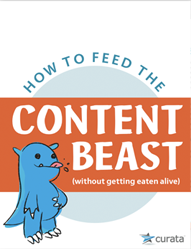- Share A Guide to Social Video: What & Where to Share on Facebook
- Share A Guide to Social Video: What & Where to Share on Twitter
- Share A Guide to Social Video: What & Where to Share on Linkedin
- Share A Guide to Social Video: What & Where to Share via email
 Time and again, studies show that humans can process visual information much faster than plain text (60,000 times faster in fact!) since 90 percent of the information transmitted to the brain is visual. Visual content, such as infographics, constantly outperform written content. So it should come as no surprise that video marketing is also on the rise, and video traffic itself will account for 67 percent of all consumer web traffic by 2017.
Time and again, studies show that humans can process visual information much faster than plain text (60,000 times faster in fact!) since 90 percent of the information transmitted to the brain is visual. Visual content, such as infographics, constantly outperform written content. So it should come as no surprise that video marketing is also on the rise, and video traffic itself will account for 67 percent of all consumer web traffic by 2017.
A recent study from Curata said that 65% of a company’s content should be created (with 25% curated and 10% syndicated). Of that created content, it is a good idea to produce a variety of content types, including video.
If you’re still skeptical about video, take these stats into consideration:
- 40 percent of people respond better to visual information
- Posts with videos attract three times more inbound links than plain text
- 85 percent of the US internet audience watch video online
- Viewers spend 100 percent more time on pages with video
While YouTube might be the most familiar and popular video network (it’s the #1 search engine in the world!), there are several others you may want to consider.
Vimeo
With 100 million visitors per month, Vimeo won’t overthrow YouTube anytime soon, but it isn’t necessarily trying to compete with its numbers. Instead, it focuses on providing high-quality and visually appealing videos. Large brands like Honda and Nokia have effectively created stunning videos that not only showcase their product, but their brand vision as well.
There are different tiers of access ranging from the basic free version to a $199/year pro version. If you’re looking to promote your business or brand, you are required to sign up for the pro version. While $199/year might sound hefty, it offers benefits such as search engine visibility, advanced tracking and statistics and customizable video players.
Unlike YouTube, Vimeo isn’t necessarily the place to post short, funny clips. Instead, you should focus on creating longer, higher-quality videos like infomercials or tutorials to showcase your professionalism. This is a great place to repurpose existing content — such as blog posts, such as eBooks and blog posts — into compelling, easy-to-watch videos.
Google Hangouts
While this may not be a traditional video-sharing platform, Google Hangouts is perhaps the best marketing platform when it comes to B2B marketing. Nearly 70 percent of businesses have a presence on Google Plus and thus have access to Hangouts. Unlike Vimeo, Hangouts focuses more on the social end of videos, as it is a video chat service. Businesses such as Mashable have used this service to share exclusive content with their customers, host live Q&A sessions and more. See their live NBA season preview hangout below.
Thanks to its recording abilities, companies can share past Hangouts as part of their content marketing strategy. And as part of Google Plus, Hangout videos will also rank higher in Google search engine results page.
Vine
Vine is Twitter’s answer to YouTube and the ever-popular gifs. Videos are short – only six seconds – and play on a continuous loop. It has been wildly successful and currently has over 40 million users. Unfortunately, it is hit or miss in terms of marketing. With such a short amount of time it can be difficult to get your point across. Still, businesses like GE and Lowes have made the most of the six seconds by offering interesting or useful videos to capture people’s attention.
You can increase your chances of reaching users by posting stop-motion videos and using the appropriate hashtags to corner your niche.
Instagram might be known for its photo sharing capabilities, but it has also allowed video uploading since 2013. Due to its easy sharing ability with other social networks, Instagram is climbing the ranks as the most used platform for B2C and B2B marketing. In fact, brands have experienced great success with Instagram as 40 percent of the most-shared videos were created by businesses. Some of the most popular brands on Instagram are Target and Intel. See two of their videos below for inspiration:
-
- Target used Instagram video to promote a charitable initiative:
-
-
- Intel used Instagram video to launch a contest:
-
In general, the most popular videos on Instagram come from the entertainment industry, retail and fashion, sports and restaurants.
Choose the Right Network
You don’t need to be on all the video networks, but you should find one that suits your business goals. While YouTube might be the largest, it won’t necessarily give you the numbers you want and it can be harder to get noticed due to the sheer amount of videos uploaded daily. Use the above information as a guide to setting up your video marketing plan, and from there decide how to approach one or two networks. Do you love to use a network not listed above? Let us know in the comments below!
For more ideas surrounding content creation as well as content curation, download our eBook How to Feed the Content Beast (without getting eaten alive).








